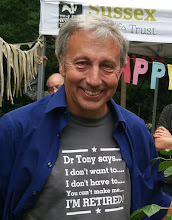Nostalgia is not, as they say, as good as it used to
be. The current push for new roads seems
to harp back to an imagined golden age when, it was thought, all you had to do
was invest in infrastructure and everything would then be fine.
Indeed, if I remember correctly, around the mid 1990’s there
was a proud boast of the biggest road building programme since the Romans
left. So, as there seems to be some
attempt to live in the past again, perhaps it is worth reminding ourselves of
the level of environmental damage that would have resulted from this previous
rush for roads.
Going from east to west the list of devastation seems almost
unimaginable today:
First at Rye there were
proposals for a major road changing the character of the old town and extending
across Rye Harbour
Then a road was proposed to run the length of the beautifully
tranquil Brede valley, devastating the wetlands there before sweeping through
the ancient woods north of Hastings
and carving across the Combe Haven Site of Special Scientific Interest.
Then there was a proposal for a dual carriageway running across
Pevensey Levels and through our own nature reserve. Again Pevensey is an internationally recognised
wildlife site and one of the most important wetlands in the whole of Britain , to say
nothing of its historical interest and landscape quality.
Further west there were proposals to run a length of dual
carriageway from Eastbourne to Lewes through
what is now the National Park.
Then we got to Worthing and proposals for a dual carriageway
cutting through the Downs and passing under
Cissbury Ring – a fantastic Iron Age Hill fort and also a nationally important
wildlife site. The quiet setting here
would have been destroyed in a futile effort to push traffic away from Worthing itself.
A little further west and of course there was a cluster of
proposals to run a dual carriageway through the largest ancient woodland on the
coastal plain in order to build an Arundel bypass.
It didn’t stop with the south coast trunk road either. A recognition that this would drive congestion
elsewhere meant that proposals for new roads throughout Sussex came thick and fast.
“Improvements” to the A24, A23, A22 and A21 going north–south,
some of which have now happened some have not.
But a dual carriageway was gong to be run through Ashdown Forest, the
biggest heathland in the south east, appreciate by thousands and again
internationally important for wildlife.
An A272 upgrade was proposed, that would have impacted at
several places, including our own nature reserve at The Mens near Wisborough
Green and driving up traffic through several villages.
There were even suggestions for an “outer” M25 running
roughly through the middle of the Weald of Sussex to relieve the pressure on
the current M25.
I suspect that half the people reading this today might say
that it couldn’t be that bad these days.
The other half might feel that a road building programme like this is a
good thing. We need roads, so wildlife,
once again, will have to be compromised.
But look again at the ever expanding list and, even ignoring the
destruction of rural Sussex ,
you don’t see a solution, you see a treadmill.
What starts as just a little
bypass here and there ends up as a treadmill with travel increasing and
congestion getting worse. Road building
is not a solution – it is a politically expedient waste of public money.
